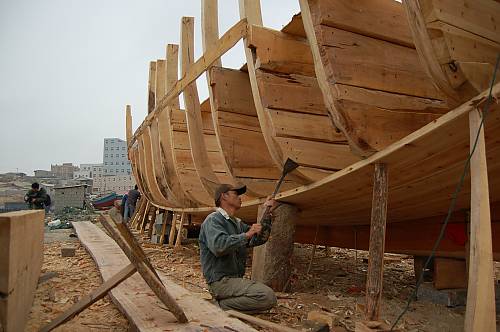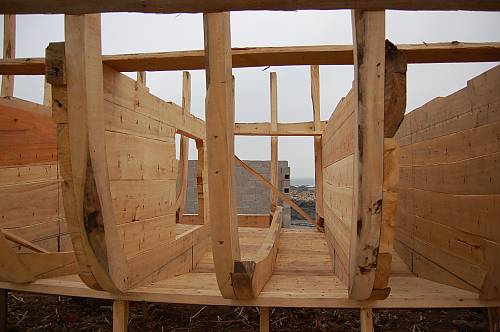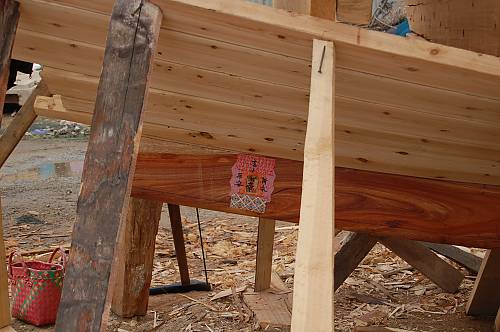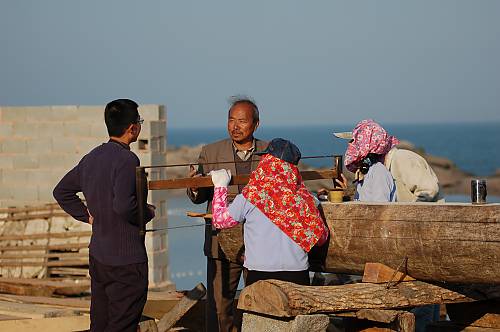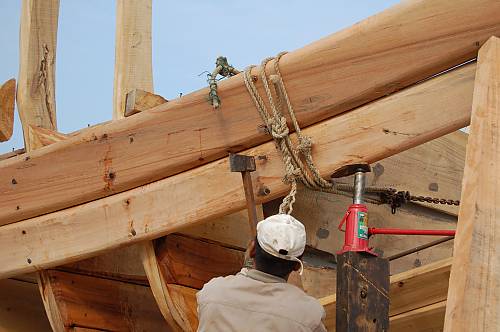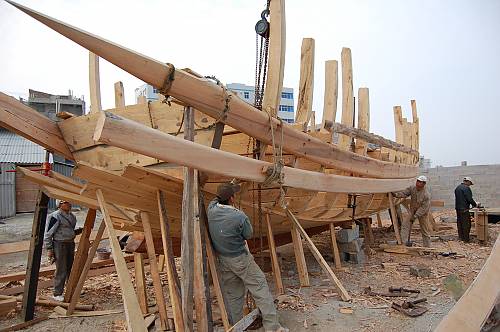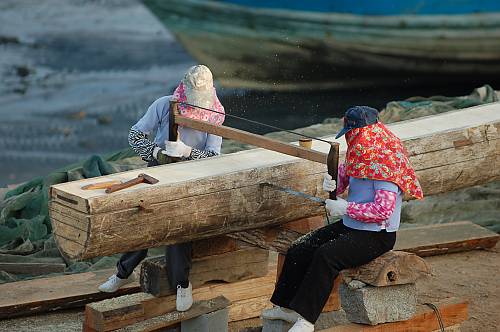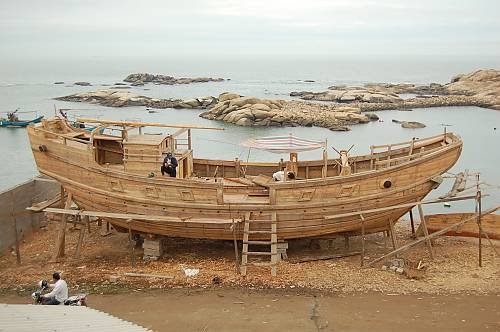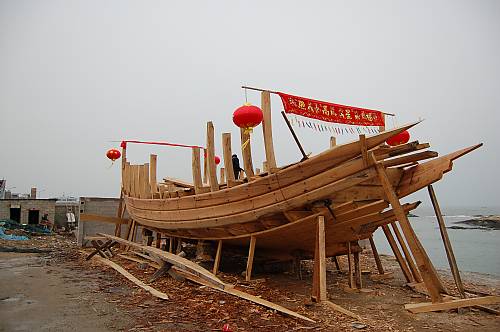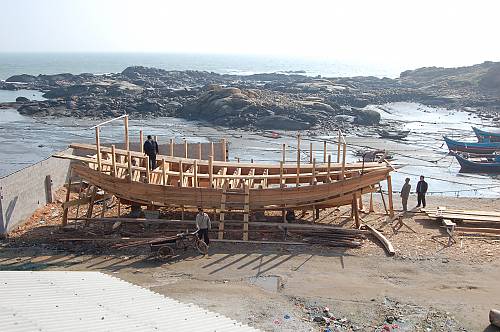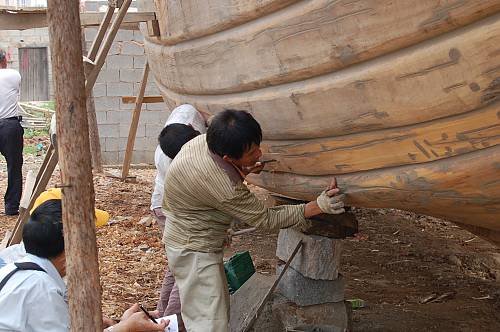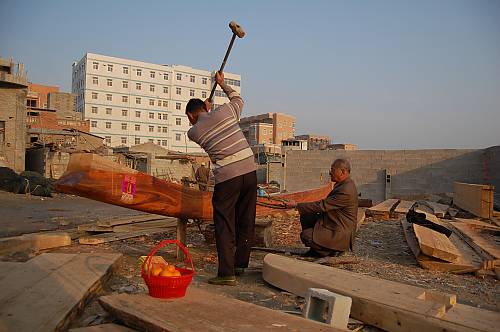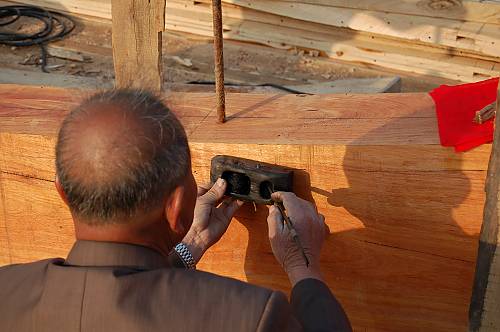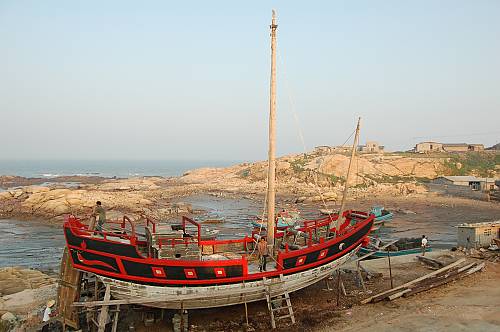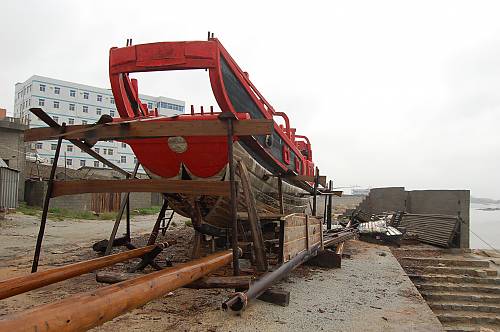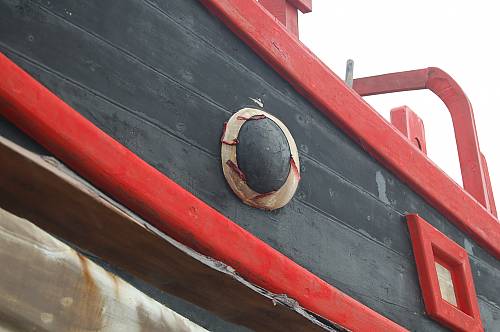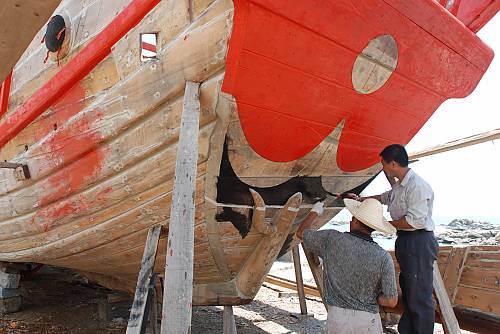Report on the status of an element inscribed on the list of intangible cultural heritage in need of urgent safeguarding
A. Cover sheet
A.1.
State Party
Name of State Party
China
A.2.
Date of deposit of the instrument of ratification, acceptance, approval or accession
This information is available online.
Date of deposit of the instrument of ratification, acceptance, approval or accession
2004-12-02
A.3.
Element inscribed on the Urgent Safeguarding List that is the subject of this report
Name of element
Report of China on the status of the ICH element 'Watertight-bulkhead technology of Chinese junks'
Inscribed in
2015
Submitting State(s)
China
A.4.
Reporting period covered by this report
Please indicate the period covered by this report.
A.5.
Other elements inscribed on the Urgent Safeguarding List, if any
Please list all other elements from your country inscribed on the Urgent Safeguarding List, together with the year of inscription; for multinational elements, please indicate the other States concerned.
Other elements inscribed on the Urgent Safeguarding List, if any
Hezhen Yimakan storytelling (2011)
Meshrep (2010)
Wooden movable-type printing of China (2010)
A.6.
Executive summary of the report
Please provide an executive summary of the report that will allow general readers to understand the current status of the element, any positive or negative impacts of inscription, the implementation of safeguarding measures during the reporting period and their possible update for the following years.
A.7.
Contact person for correspondence
Provide the name, address and other contact information of the person responsible for correspondence concerning the report.
Title (Ms/Mr, etc.)
Family name
Given name
Institution/position
Address
Telephone number
E-mail address
Other relevant information
B. Status of element inscribed on the Urgent Safeguarding List
Refer to the nomination file or to previous reports, if any, as the basis for reporting on the current status of the element, and report only on relevant changes since the date of inscription on the List or since the previous report. Nomination files, specific timetables and earlier reports, if any, are available at https://ich.unesco.org or from the Secretariat, upon request.
The State Party shall pay special attention to the role of gender and shall endeavour to ensure the widest possible participation of the communities, groups and, where applicable, individuals concerned as well as relevant non-governmental organizations during the process of preparing this report, and is asked to describe how it has done so in point D below.
B.1.
Social and cultural functions
Please explain the social and cultural functions and meanings of the element today, within and for its community, the characteristics of the bearers and practitioners, and any specific roles or categories of persons with special responsibilities towards the element, among others. Attention should be given to any relevant changes related to inscription criterion U.1 (‘the element constitutes intangible cultural heritage as defined in Article 2 of the Convention’).
Social and cultural functions
Since the inscription of the element, various safeguarding measures have been taken and the value of the venues and tools for shipbuilding and that of the ship hulls have been rejuvenated and the cultural memories associated with the heritage has been reinforced. As a symbol of local traditions and sustainable links between man and the ocean, the element has brought about cultural confidence and sustained the development of local communities. It is the cultural link for dialogue among communities, and a major contributor to the initiative of Maritime Silk Road of this date.
Communities, groups and individuals concerned regard the element as an important part of their cultural heritage. Although traditional wooden junks are getting less relevant to contemporary social life, related techniques, knowledge, and ritual traditions for junk making are still practiced and transmitted. As a cultural symbol, the element has played an ongoing role in strengthening people’s sense of identity and belonging, and raised their awareness of the importance of local history and culture.
Bearers and practitioners of the element are mainly employees of traditional shipbuilding industry. Those commanding the core technology are called “shifutou” or master craftsmen who take charge of design of the watertight bulkhead and oversee the collaboration of a large number of craftsmen working together on site. The independent watertight cabins which are connected firmly with secure tenon joints bears the knowledge of nature, the universe, and inner cognition of the communities concerned. Moreover, the spirit of collaboration shared by the bearers for the practice of this element also serves as a vital source of cultural identity for related communities, groups and individuals.
B.2.
Assessment of its viability and current risks
Please describe the current level of viability of the element, particularly the frequency and extent of its practice, the strength of traditional modes of transmission, the demographics of practitioners and audiences and its sustainability. Please also identify and describe the threats, if any, to the element's continued transmission and enactment and describe the severity and immediacy of such threats, giving particular attention to any strengthening or weakening of the element’s viability subsequent to inscription.
Assessment of its viability and current risks
The element is practiced in the communities centered around Ningde City and Quanzhou City of Fujian Province. As of this reporting period, there are 15 master craftsmen, such as Su Rendie, Chen Zhuchun, Liu Xixiu, Liu Sanji, Huang Zhenhuang, Huang Yongjin, Huang Tangyang, Huang Wentang, Huang Wutang, Huang Tongsheng, Huang Tang’an, etc., an increase of 6 from the previous cycle, and over 60 registered apprentices, while the number of other practitioners has increased to nearly 300. There are also a couple of shipyards for building various types of traditional junks, such as Fishing Port Shipyard, Fengwei Qianfeng Shipyard, Huang Yuanxiu Chinese Junks Model Yard, Tongsheng Ship Building & Repair Yard, Chinese Junks Model Making Co., Ltd., all in Quanzhou City, and Shenhu Jinquan Shipyard in Jinjiang City, and Zhangwan Shipyard in Ningde City. Bearers of the element and other stakeholders explore more creative ways and expand the space for its practice through developing ship models.
Currently, the element mainly faces the following risks:
First, its sustainability has been constrained by some external factors. Compared with ironclad powered ships, traditional wooden junks can hardly meet the needs of modern ocean navigation in terms of functionality and safety, and their manufacturing and maintenance cost is much less competitive. For example, there are special requirements for the choice of timber for building large junks. The timber should be fir, camphor or pine wood of at least 30 years old. However, the price of this kind of timber is on the high side. The cost for brushing tung oil and applying adhesive materials for maintenance is also pretty high. Therefore, the traditional practice space for the element has been greatly squeezed, and new practice space needs to be explored.
Second, the inter-generational transmission is under great pressure given the squeezed space for traditional practices. Most of the master craftsmen merely keep their knowledge, skills, experience, rules and methodologies in mind, and teach their apprentices through oral instructions which are based on their long term practice rather than accurate sketches and data. The further decline of the market demand for traditional junks has led to low practice frequency, small income and fewer successors. On one hand, the bearers are aging, and the master craftsmen are small in number and aged over 50 years on average. On the other hand, young people rarely choose junks building as their career.
B.3.
Implementation of safeguarding measures
Please report on the safeguarding measures described in the nomination file, and previous report, if any. Describe how they have been implemented and how they have substantially contributed to the safeguarding of the element during the reporting period, taking note of external or internal constraints such as limited resources. Include, in particular, information on the measures taken to ensure the viability of the element by enabling the community to continue to practise and transmit it. Include the following detailed information concerning the implementation of the set of safeguarding measures or safeguarding plan:
B.3.a.
Objectives and results
Indicate what primary objective(s) were addressed and what concrete results were attained during the reporting period.
Objectives and results
The primary objectives and results achieved during this reporting period are as follows:
1. Increased number of bearers and practitioners, and frequency of practice. Since 2019, ten new representative bearers have been recognized, bringing the current total up to 26 (including 12 in Ningde, 6 in Jinjiang, and 8 in Quangang). One representative bearer on the national list passed away in 2021. The number of the practitioners directly involved in the technical practice has increased by 28, hence up to nearly 300 in total. The local governments have further adjusted the relevant policies to ensure continuous financial support to the transmission activities. The practice frequency of traditional junks building continues to increase. The bearers and practitioners have accomplished the construction and sea trial of “Hei Bo Wu Qing An” and “Fu Ning” junks, and built more than 70 traditional junks to support cultural tourism and offshore aquaculture.
2. Strengthened inter-generational transmission. The number of training and practice centers run by bearers and shipyards has increased to 8, with over 60 registered apprentices. In the aspect of integration with vocational education, Jinjiang Vocational School has offered regular training courses on traditional junks building techniques to students since 2019.
3. Enhanced visibility due to active participation of stakeholders in extensive promotion activities. Governments at all levels and social organizations have continued to carry out promotion and demonstration events; the general public’s understanding of the traditional junks with watertight-bulkhead has been improved, and their willingness to participate in the safeguarding and transmission been strengthened. Four new exhibition venues have been built, and the number of facilities used for exhibitions and presentations increased to 20, providing site support for the purpose of information collection, technical restoration and presentation. The element has been communicated to the general public through documentaries, feature films, newspapers, TV and new media and enjoyed increasing influence. The digital cultural innovation program and the online exhibition of watertight-bulkhead technology of Chinese junks have been launched by Quangang District of Quanzhou City and Ningde City respectively, through which traditional culture has gained new connotation with the help of digital Virtual Reality. “ICH on campus” activities continue to be carried out, and special courses on junks building techniques have been offered in primary and secondary schools. School-based teaching materials and textbooks about local culture have been compiled and printed. Watertight-bulkhead technology and its cultural meanings have been disseminated to young students and the public through booming development of experiential learning and study trips.
4. New mode of safeguarding through production explored for new practice space and increased sustainability of the element. Bearers have taken the initiative in the production and sales of various traditional junk models, which were presented and marketed in the exhibitions and fairs, and gained much recognition. These products were sold to different parts of China and the rest of the world, such as Japan, France and Southeast Asia. Positive feedback gained from the market has boosted cultural exchanges at home and abroad. Meanwhile, in the practice of model ship making, the raw materials required do not necessarily depend on fir, camphor or pine wood that have grown for over 30 years; splicing materials do equally well. As a result, the cost has been reduced and sustainability has been increased.
5. Continued documentation. 13,800 photos, 130G of videos, 2.2G of written materials, 50 manuscripts, cultural and historical materials have been collected.
B.3.b.
Safeguarding activities
List the key activities that were carried out during this reporting period in order to achieve these expected results. Please describe the activities in detail and note their effectiveness or any problems encountered in implementing them.
Safeguarding activities
Key activities
1. Expanding the number of bearers and practitioners and improving practice frequency
Identifying representative bearers on a regular basis to enhance their sense of honor and enthusiasm for transmission. Ten new representative bearers have been recognized since 2019. Governments at all levels provide annual subsidies ranging from 3,000 to 20,000 yuan per person to support regular transmission and practice.
Promoting reconstruction and renovation of traditional junks by local governments in corporation with shipyards to provide practice opportunities for bearers. “Dabei” junk was under repair and maintenance from 2019 to 2022. From June 2020 to January 2021, Quanzhou Chinese Junks Model Making Co., Ltd. formed a special team to accomplish the reconstruction and sea trial of “Hei Bo Wu Qing An” junk. In 2019, the bearer Liu Dengchuan organized a team to build a traditional junk for “Minyue Rivertown”, a cultural tourism project in Fuzhou City. Zhangwan Shipyard, as commissioned by ship owners, has built 67 small wooden ships and 3 large traditional junks for offshore aquaculture operation from 2019 to 2022, with the involvement of 46 bearers and 15 apprentices.
2. Promoting inter-generational transmission
Since 2019, three training and practice centers have been identified (Maritime Museum of Traditional Junks, Huang Yuanxiu Chinese Junks Model Yard, and Tongsheng Ships building & Repair Yard, all in Quangang District of Quanzhou City) to support the training of successors through master-apprentice mode. Jinjiang Vocational School, among others, has incorporated watertight-bulkhead techniques into special courses. It also provides weekly training for young students as potential practitioners.
3. Enhancing visibility through public promotion
Building exhibition halls for demonstration and presentation of the element with support of local governments, businesses and bearers. Since 2019, Jinjiang ICH Exhibition Hall, Quangang Maritime Museum of Traditional Chinese Junks, Quangang Maritime ICH Exhibition Hall and China Cultural Exhibition Center of Chinese Junks (Ningde Zhangwan Pavilion) have been set up. Among them, Quangang Maritime Museum of Traditional Chinese Junks, with a total area of 3,150 square meters, has been awarded as “Experiential Research Base of Maritime ICH” and “Training Base of Watertight-bulkhead Technology for the Youth in Fengwei Town”.
Promoting and demonstrating the watertight-bulkhead technology more than 20 times a year on the Cultural and Natural Heritage Day and during major festivals, and supporting bearers to attend various exhibitions and exchange activities inside and outside the province so as to improve the public awareness of the element. The cultural park of the element was built in Quangang District, and a large traditional junk has settled in Minyue Rivertown, with a view to promote dissemination through tourism.
Using mass media for publicity. Since 2019, five documentaries and feature films have been produced, such as “Watertight-bulkhead Technology of Chinese Junks, an ICH work of Ingenuity”; the element has been introduced through such TV programs as ICH Open Class; over 10 articles about the element have been published; official website and WeChat account of the element have been set up and new media has been channeled for promotion.
Proceeding with “ICH on campus” activities. Special courses about the element are provided in primary and secondary schools and kindergartens in Quangang District, Jinjiang and Ningde cities all year round. The watertight-bulkhead technique has been compiled into the Textbook about Local Culture and teaching materials of schools, and bearers are regularly invited to teach on campus.
Strengthening cooperation with colleges and universities. College of Fine Arts of Huaqiao University has set up a base for painting from nature where the element is practiced to facilitate cooperation and disseminate related knowledge. Developing experiential learning and encouraging bearers to develop extra-curricula materials such as Quick Start Manual for Chinese Junks Making, Chinese Junks Building Workshop and other popular readings about detachable and reusable Chinese junk models. Venues like Cultural Research Base of Chinese Junks in Quangang District (established in 2021) have hosted more than 100 study tours, accepting 30,000 visits.
Exploring digital means for cultural creation. In 2021, “Digital Cultural and Creative Program about Watertight-bulkhead Technology of Chinese Junks” was jointly implemented by Quanzhou City and Tencent’s New Cultural Creative Headquarters, as a platform to share cultural and creative programs along the Maritime Silk Road. In 2022, Culture and Tourism Bureau of Ningde City launched an online exhibition hall to showcase watertight-bulkhead technology by virtue of VR technology and Internet-based digital tools, allowing audience online to watch any video on-demand through mobile phones.
4. Expanding practice space for sustainable development
Bearers have carried out research and development, production and sales of diversified ship models voluntarily. The number of companies engaged in model ship building and product research and development has increased from 2 to 4. Related products have been exhibited in the 12th China (Putian) Crafts Expo Across the Strait, and listed in the official category of local specialties of Quanzhou and top ten gifts of Xiamen. Over 10 cultural products associated with the element such as the ship models of “Zheng He Treasure Ship” “Zheng Chenggong Treasure Ship” and “Hei Bo Wu Qing An” have obtained national patents and trademarks.
5. Documentation
Collecting and preserving data by stakeholders in Jinjiang, Ningde and Quanzhou cities. 13,800 photos, 130G of digital video, written materials, 50 design manuscripts, cultural and historical materials will be used for compilation of teaching materials for training and “ICH on campus” activities.
Problems to be solved
1. With the aging of bearers, the inter-generational transmission is still under great pressure. At present, efforts have been made to integrate with vocational education for training of future practitioners, hence the number of young people acquiring watertight-bulkhead technology in Zhangwan has increased in recent years. However, not many young people could keep to the practice; the inter-generational transmission pressure hasn’t been eased fundamentally.
2. External factors have challenged the sustainable practice of the element. For example, “Hei Bo Wu Qing An” junk hasn’t got navigation permit yet since its construction.
3. Due to the COVID-19 pandemic, the frequency of offline demonstration and experiential learning activities has decreased; academic exchanges and expert meetings were not organized as planned.
B.3.c.
Participation of communities, groups or individuals in the safeguarding activities
Describe how communities, groups or, if appropriate, individuals as well as relevant non-governmental organizations have effectively participated, including in terms of gender roles, in the safeguarding measures. Describe the role of the implementing organization or body (name, background, etc.) and the human resources that were available for implementing safeguarding activities.
Participation of communities, groups or individuals in the safeguarding activities
1. The essential role of bearers in the safeguarding. During this reporting period, bearers have taken the initiative in the following safeguarding practice and transmission activities: they have completed the construction of three traditional junks, i.e.“Hei Bo Wu Qing An” “Fu Ning” and the one in Minyue Rivertown; bearers such as Liu Xixiu, Huang Zhenhuang and Huang Tang’an have set up training and practice centers on the premises of their studios and shipyards, and have trained 3 to 5 apprentices per person; bearers like Chen Chunlai have been consistently teaching in the vocational institutions, primary and secondary schools, and developing teaching materials and tools, as well as nearly 100 kinds of traditional junk models; Yang Liangdun and Chen Chunlai have participated in Guangzhou Cultural Industry Fair, Quanzhou Special Exhibition of Chinese Arts and Crafts Museum and other exhibitions organized by National Arts Fund; they have joined the filming of CCTV’s ICH Open Class, and Chinese Civilization Series to explain the culture and technical tradition of the element. It should be noted that, despite the fact that men are dominant in the practice, the wives of some bearers have been gradually involved in the restoration and production of traditional junk models, mainly responsible for making sails.
2. Active participation of enterprises. More opportunities have been created for the practice of the element due to the involvement of enterprises such as Quanzhou Chinese Junks Model Making Co. Ltd., Fengwei Fishing Port Shipyard, Huang Yuanxiu Chinese Junks Model Yard, Tongsheng Ship Building & Repair Yard and Shenhu Jinquan Shipyard in Jinjiang City, who have established training and practice centers on their premises with more than 10 permanent apprentices. In July 2020, Quanzhou Chinese Junks Model Making Co. Ltd. invested over 4.7 million yuan to reconstruct “Hei Bo Wu Qing An” junk with the involvement of 28 bearers. Zhangwan Shipyard in Jiaocheng District of Ningde City now has 46 permanent workers. It has produced about 67 small wooden junks and 3 large traditional junks since 2019.
3. Contribution of educational institutions to dissemination and promotion. Jinjiang Vocational School of Fujian Province has set up a training and practice center for teaching watertight-bulkhead technology all year round, bringing institutionalized training for young practitioners. Primary and secondary schools such as No. 3 Experimental Primary School in Quangang District, Ningde No. 9 Middle School, Jiaocheng No. 1 Primary School and Zhangwan Central Primary School have organized “ICH on campus” activities and study tours. Practical courses for detachable junk models were provided in the comprehensive demonstration base for primary and secondary school students in Jinjiang, benefiting nearly 500 students in 2022.
4. Communities’ active participation in the safeguarding and transmission. Relevant communities of the element, including Shenhu and Jinjing towns of Jinjiang City, Chengfeng and Chengping villages of Fengwei Town in Quangang District of Quanzhou City, and Zhangjiang Community, Zhangwan Village and Haiying Village of Zhangwan Town of Ningde City, have got a stronger sense of cultural identity and more enthusiasm for the safeguarding of the element. Organizations such as Quangang Association for Safeguarding, Development, and Promotion of Watertight-bulkhead Technology of Chinese Junks of Quanzhou City and Watertight-bulkhead Chinese Junks Research Society, Jiaocheng District of Ningde City, have been established to make and demonstrate traditional junk models and facilitate communication and dialogue at the community level, resulting in improved social recognition and attention of aforesaid communities, groups and individuals.
B.3.d.
Timetable
Indicate in a timetable when each activity was implemented.
Timetable
Supporting bearers' transmission activities
From 2019 to 2022, the central finance, Fujian provincial finance, Quanzhou and Jinjiang municipal finance continued to subsidize the bearers of the element for their transmission and practice, and for training of over 60 registered apprentices.
In 2021 and 2022, two training workshops of ICH safeguarding for representative bearers were held in Quanzhou City.
In 2019, the bearer Liu Dengchuan and his team built a traditional junk for Minyue Rivertown in Fuzhou City.
In February 2019, the “Fu Ning” junk, built with the help of the bearer Liu Xixiu, was launched for sea trial.
From 2019 to 2022, Zhangwan Shipyard built more than 70 large, medium and small-sized junks for offshore aquaculture operation.
From June to December 2020, Quanzhou Chinese Junks Model Making Co. Ltd. formed a shipbuilding team to reconstruct a 30 meters long and 2.15 meters high watertight-bulkhead junk—“Hei Bo Wu Qing An” of 80 tons. The sea trial of the junk was launched on January 13, 2021.
From 2021 to 2022, bearers Chen Chunlai and Yang Liangdun jointly developed a low-cost and glue-free junk model DIY kit, which has obtained the national patent and has been listed in the category of local specialties of Jinjiang City.
Since 2020, the government of Quangang District has been cooperating with Tencent’s New Cultural & Creative Headquarters to develop Digital Cultural & Creative Project of Watertight-bulkhead Technology of Chinese Junks as a platform for sharing cultural and creative programs along the Maritime Silk Road.
Promotion and dissemination through education
From 2019 to 2022, representative bearers of Quangang District kept visiting once a week to offer watertight-bulkhead technology-related courses in primary and secondary schools and kindergartens.
From 2019 to 2022, Jinjiang Vocational School held weekly training workshops on watertight-bulkhead technology.
In January and August 2022, the government of Shenhu Town organized two “Back to School & Hometown” campaigns for college students, including two experiential activities about the element, participated by nearly 100 college students.
In 2022, practical courses about detachable junk models were offered in Jinjiang comprehensive demonstration base for primary and secondary school students.
Building and improving exhibition facilities
In April 2020, the government of Shenhu Town upgraded the multimedia teaching equipment and display board of the Watertight-bulkhead Technology Training and Practice Center.
In April 2020, Ningde City upgraded the multimedia teaching equipment and display board of the Watertight-bulkhead Technology Training and Practice Center.
From 2020 to 2021, China Cultural Exhibition Center of Chinese Junks (Zhangwan Pavilion in Ningde) was renovated and its interior display board was upgraded.
In January 2021, the display walls and signage system were built in Ningde City for promoting traditional junks.
In 2021, the entrepreneur Lin Peizong invested in the construction of Maritime Museum of Watertight-bulkhead Chinese Junks, covering an area of 3,150 square meters in Chengping Village of Fengwei Town, Quangang District.
In December 2021, the government of Shenhu Town upgraded the practice and experience area in the Watertight-bulkhead Technology Training and Practice Center.
Participating in cultural exchanges and exhibitions
In June 2019, bearers from Quanzhou and Ningde participated in the activities organized by the Ministry of Culture and Tourism on Cultural and Natural Heritage Day and the filming of “ICH Open Class” program by CCTV.
In October 2019, the camera crew of Anhui Satellite Television’s program the Power of Youth visited the manufacturing base of Chinese junks.
In April 2020, Ningde TV Station filmed Light of East Fujian series program about watertight-bulkhead junks in Zhangwan of Jiaocheng City.
In May 2020, the camera crew of CCTV documentary the Shipwreck of Nanhai No. 1 held an exhibition about watertight-bulkhead technology in Ningde City.
In July 2020, the documentary “Watertight-bulkhead Technology of Chinese Junks, an ICH Work of Ingenuity” was filmed in Ningde City to show the achievements in the safeguarding of the element in the past decade since its inscription on the USL.
In August 2020, the bearer Liu Xixiu and his apprentices participated in the “Chinese Dream & Cultural Promotion” event organized by CCTV in Ningde City.
In May 2021, the officials from local governments of Ningde City and Jiaocheng District, members of research institutes and representative bearers participated in the filming of “Geography in China” program by CCTV.
In July 2021, the WeChat Account of We-media “Ningde Traditional Chinese Junks” was officially put into operation.
In July 2021, Fujian Branch of China News Service interviewed the bearers and made a specific report on the watertight-bulkhead technology.
In December 2021, the documentary “the Beauty of Watertight-bulkhead Technology of Chinese Junks” was produced jointly by Culture, Sports and Tourism Bureau and Cultural Center of Quangang District of Quanzhou City.
From 2019 to 2022, ICH exhibitions were held on Cultural and Natural Heritage Day, co-sponsored by Jinjiang City, Quangang District of Quanzhou City, Culture and Tourism Bureau of Ningde City.
In June 2022, Quanzhou Culture, Radio, Film and Tourism Bureau and Quanzhou Maritime Museum hosted a demonstration and experiential learning event on the Museum Day about watertight-bulkhead technology of Chinese junks, participated by about 500 people.
B.3.e.
Budget expenditures
Provide the detailed amounts of the funds used for the implementation of each activity (if possible, in US dollars), identifying the funding source for each (governmental sources, in-kind community inputs, etc.).
Budget
Government resources
From 2019 to 2022, the central finance provided annual subsidies of 20,000 yuan per person to the national-level representative bearers Liu Xixiu and Huang Zongcai; Fujian Province provided annual subsidies of 6,000 yuan per person to 6 provincial-level representative bearers; Quanzhou provided annual subsidies of 3,000 yuan per person to 7 municipal-level representative bearers (2,000 yuan per person for those under 60 years old); Jinjiang provided annual subsidies of 5,000 yuan to 1 provincial-level representative bearers and of 3,000 yuan per person to 2 municipal-level representative bearers.
In 2021 and 2022, two training workshops in Quanzhou City, 30,000 yuan per year;
From January 2019 to August 2022, repair and maintenance of Dabei junk, 60,000 yuan; salary expenditure for the maintenance workers, 110,000 yuan;
In April 2020, improvement of the multimedia teaching equipment and display board of the Training and Practice Center in Shenhu Town, 80,000 yuan;
In 2021, building Maritime Museum of Traditional Chinese Junks in Chengping Village, Fengwei Town of Quanguang District, 750,000 yuan;
In December 2021, improving the practice and experience area in the Training and Practice Center of Shenhu Town, 40,000 yuan;
In May 2022, moving “Hei Bo Wu Qing An” junk into Jinxiu Lake of Quangang District, 500,000 yuan;
From 2019 to 2022, supporting bearers to teach at Jinjiang Vocational School on a weekly basis, 130,000 yuan per year;
In January and August 2022, two experiential activities about the element for college graduates, as part of the “Back to School & Hometown” campaign in Shenhu Town, about 10,000 yuan;
From 2019 to 2022, supporting representative bearers to carry out “ICH on campus” activities in primary and secondary schools and kindergartens in Quangang District, 500,000 yuan;
In December 2021, production of the documentary “Beauty of Watertight-bulkhead Technology of Chinese Junks”, 50,000 yuan;
In June 2022, exhibition and experiential activities about the element held in Quanzhou Maritime Museum, 50,000 yuan;
In the second half of 2022, experiential activities about the element in Jinjiang City, nearly 80,000 yuan;
In January 2021, building cultural walls and signage system for promoting the element, 140,000 yuan;
In April 2020, improving multimedia teaching equipment and display board in the training and practice centers, 80,000 yuan;
From May to December 2020, renovating China Cultural Exhibition Center of Chinese Junks (Zhangwan Pavilion in Ningde City) and its interior display boards, 450,000 yuan;
In 2021, upgrading China Cultural Exhibition Center of Chinese Junks (Zhangwan Pavilion in Ningde), 220,000 yuan;
From 2019 to 2021, supporting bearers from Quanzhou to attend various exhibitions and exchanges, accumulated 300,000 yuan.
In June 2019, bearers from Ningde attending Cultural & Natural Heritage Day activities and CCTV’s ICH Open Class program, 80,000 yuan.
In June of 2019 and 2020, ICH exhibitions and performances on Cultural & Natural Heritage Day in Ningde City, 10,000 yuan per year;
In October 2019, Anhui Satellite Television visiting the manufacturing base of Chinese Junks in Ningde City, 30,000 yuan;
In November 2019, attending the Program Release & Award ceremony for the Safeguarding and Transmission of Traditional Chinese Junks as part of the 13th China Cup Race event in Ningde, 50,000 yuan;
In May 2020, demonstrating the watertight-bulkhead technology in Ningde to support the filming of the Documentary “the Shipwreck of Nanhai No. 1”, 10,000 yuan;
In August 2020, Liu Xixiu and his apprentices’ participating in CCTV’s Chinese Dream & Cultural Promotion program in Ningde, 10,000 yuan;
In April 2020, filming the Light of East Fujian series about Zhangwan traditional junks in Jiaocheng District, 5,000 yuan;
In May 2021, filming of the documentary “Geography in China” of the CCTV Science and Education Channel with participation of the members of Jiaocheng Research Institute and representative bearers, 5,000 yuan;
In July 2021, interviewing the bearers and making a specific report on the watertight-bulkhead technology by Fujian Branch of China News Service, 5,000 yuan;
In July 2021, maintenance and operation of We-media “Ningde Traditional Chinese Junks” WeChat Account, 78,000 yuan;
In July 2020, shooting the documentary “Watertight-bulkhead Technology of Chinese Junks, an ICH Work of Ingenuity”, 80,000 yuan.
Input from social organizations, enterprises and individuals
From June to December 2020, Quanzhou Chinese Junks Model Making Co. Ltd. invested 580,000 yuan on the reconstruction of “Hei Bo Wu Qing An” junk;
From November 2021 to May 2022, Quanzhou Chinese Junks Model Making Co. Ltd. spent 1.62 million yuan on a couple of events related to “Hei Bo Wu Qing An” junk, including Mast Erection & the opening ceremony of the documentary “Beauty of Watertight-bulkhead Technology of Chinese Junks”, launching ceremony, trial voyage ceremony, as well as moving the junk into Jinxiu Lake of Quanguang District;
Since 2020, Tencent has spent 5 million yuan on “digital cultural & creative program on watertight-bulkhead Technology of Chinese junks”;
From 2019 through 2022, Huan Yuanxiu Chinese Junk Model Yard and Tongsheng Ship Making & Repair Yard in Quangang District of Quanzhou City invested 500,000 yuan on the making and R&D of the model products;
In 2021, local entrepreneur Lin Peizong invested 4.71 million yuan on the construction of Maritime Museum of Chinese Junks;
From 2021 through 2022, the bearer Chen Chunlai invested about 50,000 yuan on the development of Chinese junk models and DIY model sets.
B.3.f.
Overall effectiveness of the safeguarding activities
Provide an overall assessment of the effectiveness of the activities undertaken to achieve the expected results and of the efficiency of the use of funds for implementing the activities. Please indicate how the activities contributed to achieving the results and whether other activities could have contributed better to achieving the same results. Also indicate whether the same results could have been achieved with less funding, whether the human resources available were appropriate and whether communities, groups and individuals could have been better involved.
Overall effectiveness of the safeguarding activities
Bearers and practitioners, community-based associations, local institutes, enterprises, governments at different levels, academia and the media have all contributed to the implementation of the safeguarding measures. Policies and regulations at different levels, such as Opinions on Further Strengthening the Safeguarding of ICH, Regulations on the Safeguarding of Ethnic and Folk Culture in Fujian Province, Work Plan for Comprehensive Pilot Programs of Safeguarding Ethnic and Folk Culture in Quanzhou City, and Measures for the Identification and Management of Representative Bearers of ICH Elements in Quanzhou City, provide legal basis and institutional guarantee for the safeguarding and transmission of the technology and effective use of funds. During this reporting period, the proposed safeguarding measures have been implemented and the expected results achieved.
Improved visibility and viability. Documentation of collected texts, pictures and audiovisual materials is fundamental to preservation and promotion of the element; training and practice centers, model ship museums and exhibition halls have continued to play their due supporting role; research activities and courses organized by training and practice centers, research bases and schools and universities, publicity of major media platforms, frequent technological exchanges and exhibitions, and the active participation of local institutes and enterprises have all contributed to the enhanced visibility of the element.
Support for bearers. Representative bearers are subsidized by governments at different levels. Training workshops were held every year to offer bearers access to scientific knowledge and practical methods for the safeguarding and transmission. In addition, the measures are generally inclusive to people of different genders and ages, which has noted and underline the significant role of women in such work as mending sails and fishing nets of junks, and in related folk activities.
Innovative mode of transmission. More attention has been paid to exploring sustainable transmission from perspectives of research and development of watertight-bulkhead technology and expansion of market demand. Research has been conducted on the development and creation of detachable and reusable Chinese junk models, sculptured reliefs of Chinese junks, and creative relief murals of Chinese junks. The Chinese junk models have been produced in cooperation with companies, parks, museums and exhibition halls, and presented in the crafts expo and selection of local specialties activities. Efforts have also been made to apply for national patents for these products and explore more safeguarding methods and applications. In recent years, those model products have been sold or presented as gifts to the rest of the country and abroad to Japan, France, Southeast Asia and other countries and regions, which has promoted cultural exchanges and generated more income for the bearers and practitioners.
Fund raising and utilization. Financial support has taken forms of government subsidies, business sponsorship and donations from the civil society. Governments at different levels have formulated a series of rules and regulations for safeguarding management such as infrastructure construction, funding for bearers, incorporation with education, promotion and demonstration, and technological R&D with a view to the effective use of funds for safeguarding purpose.
At present, the element enjoys better supportive facilities, growing population of bearers, improved documentation, enhanced promotion and education, and growing social recognition. Fund raising channels are diverse and the use of fund is relatively efficient. Technology-related academic exchanges are proceeding ahead steadily. However, technology R&D and academic exchanges is still less sufficient. Although the watertight-bulkhead technology is still applied to the modern shipbuilding industry, the element can hardly be applied to modern social and economic activities, thus causing tough challenges to its transmission. Cooperation and participation by more stakeholders are needed to support technology development and creation and expansion of market demand, so as to stimulate the sustainable development of the element.
C. Update of the safeguarding measures
C.1.
Updated safeguarding plan
Please provide an update of the safeguarding plan included in the nomination file or in the previous report. In particular provide detailed information as follows:
- a. What primary objective(s) will be addressed and what concrete results will be expected?
- b. What are the key activities to be carried out in order to achieve these expected results? Describe the activities in detail and in their best sequence, addressing their feasibility.
- c. How will the State(s) Party(ies) concerned support the implementation of the updated safeguarding plan?
Updated safeguarding plan
a. Primary objectives and expected results
In the next reporting period, major efforts will be made in the following aspects:
To promote inter-generational transmission as the first priority and train successors.
To explore new path of safeguarding through production, expand practice space, increase practice frequency, strike for a balance between the safeguarding of traditional technology and market-based operation, and ensure that relevant communities are always the primary beneficiaries.
To strengthen the overall research and documentation, promote preservation, development and use of relevant spaces for practice, collection, protection and use of relevant tools and objects, and research of related customs and rituals, further digitize archiving and provide better space and platform for the practice and transmission of the element.
To promote the establishment of a cooperative network of multiple actors, facilitate interaction of experts, scholars, research associations with bearers, practitioners and trade associations, encourage enterprises, financial institutions and the media to participate extensively in safeguarding activities, and jointly formulate more scientific and systematic safeguarding measures.
To strengthen communication and exchanges, enhance public awareness and interest in the element, and create a good social atmosphere, promote community-based dialogue, encourage communities and bearers to participate in domestic and international exchanges and cooperation, and share the history and culture about peaceful use of the ocean.
b. Activities to be conducted
To identify more bearers, provide financial subsidies and venue support for bearers to carry out transmission and teaching activities, organize workshops for bearers, and ensure the stability of the transmission practitioners. For example, apart form national and provincial subsidies, Jinjiang City will provide representative bearers extra subsidies from 3,000 to 10,000 yuan for each every year, which will be used for documentation, presentation and demonstration, academic exchanges, teaching apprentices and other transmission activities.
To keep the practice frequency by renovating old junks and building new ones, introduce social resources and encourage enterprises to cooperate with bearers and communities to produce and develop new ship models, publicize and develop techniques and culture of the element, and develop cultural and creative products that could retain the cultural connotation of the element and be fun at the same time, and help relevant communities and bearers to gain economic benefits.
To promote the integration of the element with formal and vocational education, develop ICH teaching materials for primary and secondary schools, and incorporate cultural knowledge and the making of Chinese junk models into practice courses, carry out experiential research activities suitable for students from primary and secondary schools, colleges and universities.
To develop Online Community for Transmission and Digital Cultural Creation programs, carry out cultural activities on Chinese junks for local communities and train more followers and practitioners.
To invite domestic experts and scholars to provide intellectual support for the development of more realistic safeguarding measures and carry out relevant research, organize ICH bearers, community organizations and trade associations to get involved in academic exchanges, encourage bearers to attend technological competitions and exchange activities at home and abroad.
Governments and competent bodies for safeguarding at all levels will further cooperate with traditional and new media to promote the element and related culture, so as to increase visibility and raise public awareness and interest.
c. Government support for the implementation
The Chinese government undertakes to further fulfill its responsibilities and obligations as a State Party to the Convention. In order to ensure the viability of the element, it will always respect the willingness of the communities, groups and individuals concerned, and formulate policies and provide institutional, administrative, financial, human resources and technical support for the implementation of the updated safeguarding measures. Local governments will make supportive policies, financial subsidies and venues available for bearers to carry out practice and teaching activities. Human and financial support will be provided for the construction and upgrading of ICH training and practice centers, exhibition halls, museums and thematic cultural parks. Various media resources will be channeled for the promotion of the element. Enterprises, trade associations, communities and bearers will be coordinated to hold festive ceremonies, competitions and activities related to the element and provide financial support if necessary, and relevant communities, groups and individuals will get involved in the whole safeguarding process to the maximum extent possible to promote better safeguarding results and creative development of the element and enhance its viability.
C.2.
Timetable for future actitivies
Provide a timetable for the updated safeguarding plan (within a time-frame of approximately four years).
00302,00303,00304,00305,00321,00322,00530
Timetable
The following activities are proposed for the next four years according to the updated safeguarding plan.
1. To promote inter-generational transmission
Organize regular training for bearers every year; support and encourage bearers to compete in various contests of arts & crafts and techniques, develop new model ships, and participate in domestic and foreign cooperation and exchanges; invite bearers to teach at the community-based primary and secondary schools on a weekly basis by using related extracurricular teaching materials from March to June and from September to December each year; carry out experiential activities for the public in the existing training and practice centers, exhibition halls, research bases and Chinese junks model museums from July to August and from January to February each year.
2. To expand space of practice
2022 to 2026: Build or renovate two Chinese junks to promote the safeguarding through practice. A 42-meter-long “Hei Bo Wu Qing An” junk is to be built in Quangang District; a traditional “anchor hawser junk” will be reproduced and used as facilities of experience in the manufacturing base of watertight-bulkhead Chinese junks in Ningde City.
2023 to 2024: Hold an exhibition of watertight-bulkhead technology in Jinjiang District; celebrate the Cultural Festival of Chinese Junks in Ningde City.
2023 to June 2026: Hold a model ship building contest once a year in the industrial base of watertight-bulkhead Chinese junks of Quanzhou Chinese Junks Model Making Co., Ltd.
3. To ensure venues and facilities necessary for practice and transmission
2023: Build an ICH experience center in Ningde City.
2023: Digitalize and upgrade the area of watertight-bulkhead technology of Chinese junks in Jinjiang ICH Exhibition Hall.
2024: Digitalize and upgrade the Model Ship Museum in Shenhu Town of Jinjiang City.
2024 to June 2026: Improve the training and practice base of watertight-bulkhead technology of Chinese junks in Ningde City;
Documentation and digitalization will be carried out along with the construction and renovation of these venues.
4. To conduct thematic research
2023 to June 2026: A special research on the element will be conducted. Two books about the general history of Maritime Silk Road, “the History and Technology of Shipbuilding in China” and “the Atlas of Watertight-bulkhead Technology of Chinese Junks”, are planned to be published by Ningde City and Quangang District. Academic seminars on the element will be held occasionally. In addition, in Ningde City, teaching materials for transmission and “ICH on campus” activities will be developed; traditional tools and objects related to transmission and practice of the element will be collected and purchased to enrich demonstration.
C.3.
Budget for future activities
Provide the estimates of the funds required for implementing the updated safeguarding plan (if possible, in US dollars), identifying any available resources (governmental sources, in-kind community inputs, etc.).
Budget
The central and provincial governments will continue to provide annual subsidies to the representative bearers for their transmission and practice from 6,000 to 20,000 yuan each. In addition, municipal governments will provide annual subsidies from 2,000 to 3,000 yuan each for representative bearers according to their age. The government of Jinjiang City will continue to provide extra financial support to bearers from 3,000 to 10,000 yuan on a yearly basis.
500,000 yuan for developing teaching materials for transmission and experiential activities, collecting or purchasing necessary tools and objects for transmission and practice in Ningde City.
300,000 yuan for restoring the traditional “anchor hawser junk” in Ningde City. The manufacturing base of watertight-bulkhead technology of Chinese junks in Ningde City will be used as the venue for subsequent practice and display.
5 million yuan for building an even larger “Hei Bo Wu Qing An” junk in Quangang District. This project will be co-financed by the government and enterprises. Quanzhou Chinese Junks Model Making Co., Ltd. has set the stage.
3 million yuan for holding technology exhibitions, cultural festival of Chinese Junks and model ship contests. The funds will mainly come from government resources and corporate sponsorship. Currently, venues for these activities are available.
250,000 yuan for digitalizing the display of watertight-bulkhead technology of Chinese junks in Jinjiang ICH Exhibition Hall and Jinjiang Museum of Watertight-bulkhead Technology of Chinese Junks, of which 50,000 yuan has been applied for as the special ICH fund in 2023;
1 million yuan for building Ningde ICH Experience Center; 50,000 yuan for improving Ningde Watertight-bulkhead Technology Training and Practice Base;
600,000 yuan for the compilation of the Atlas of Watertight-bulkhead Technology; 200,000 yuan for the compilation of the History and Technology of Shipbuilding in China.
Other inputs:
The enterprises engaged in the production of Chinese junks and model ships (including shipyards, model ship museums, model ship studios, etc.) will provide technological, material and in-kind (venue) support for training of bearers, exhibitions, model ship contests, and related research activities. The communities, local associations, enthusiasts of watertight-bulkhead technology and individuals will further contribute human, material and financial resources voluntarily to support the safeguarding and transmission of the element.
C.4.
Community participation
Please describe how communities, groups and individuals, as well as relevant non-governmental organizations have been involved, including in terms of gender roles, in updating the safeguarding plan, and how they will be involved in its implementation.
00045
Community participation
The relevant communities, groups, bearers and other stakeholders of the element have actively participated in the updating of the safeguarding plan. They have made suggestions, cooperated with the research, and will surely play their part in the implementation of the plan in the future.
1. The bearers, who enact the element and are main actor of the safeguarding efforts, are responsible for the practice, transmission and innovation of the technology, and will participate in various safeguarding activities. For example, Chen Chunlai, one of the representative bearers, has cooperated with the Film School and the School of Creativity and Innovation of Xiamen University to conduct the research on the sustainable development mode combining traditional watertight-bulkhead technology with modern technology. Various social forces and more bearers are welcome to join this research program. Other bearers such as Su Rendie, Yang Liangdun, together with Chen Chunlai, have planned to develop and build more than six types of representative Chinese junks.
2. The communities will initiate or participate in various activities to raise the public awareness of the element and create a good social atmosphere. They can be the informants for field studies. New social organizations can be established to support model ship building, transmission and the safeguarding and cultural dissemination of the element.
3. Women are encouraged to take part in the process of practice and knowledge dissemination. While maintaining their vital role in the rituals of ship building and mending of fishing nets and sails, women are further encouraged to directly involved in the painting of traditional wooden junks and the sails making of the model ships. Besides, as activities such as “ICH on campus” and experiential studies are gender inclusive, all male or femail students can participate in the practice and experiential learning of the element. Women will make their due contribution to the viability and transmission of the element.
4. Enterprises such as Chinese junks museum and shipyards are active in investing in or participating in traditional junks renovation projects, employing bearers to lead research and development of model ship products, setting up engineering teams and building transmission venues, thus laying a foundation for the sustainable development of the element. In the future, they will pay more attention to further exploration and research and development of model ship making, avoid the risk of core technology loss triggered by industrialization, and find a better business model for market expansion and effective transmission.
5. Media, educational institutions, experts and scholars will be more active in joining the development and implementation of the safeguarding plan to further increase the visibility of the element. Through formal education and experiential learning, the public will be more aware of the element, and related marine culture and knowledge, and the overall cultural research of the element will be strengthened.
C.5.
Institutional context
Please report on the institutional context for the local management and safeguarding of the element inscribed on the Urgent Safeguarding List, including:
- a. the competent body(ies) involved in its management and/or safeguarding;
- b. the organization(s) of the community or group concerned with the element and its safeguarding.
2004-12-02
Institutional context
a. The competent bodies involved in its management and/or safeguarding:
Culture and Tourism Department of Fujian Province, China
Culture and Tourism Bureau of Jinjiang City, Fujian Province
Culture, Sports & Tourism Bureau of Quangang District, Quanzhou City, Fujian Province
b. The organizations of the community or group concerned with the element and its safeguarding:
Community organizations:
Cultural Center of Jinjiang City, Fujian Province
Cultural Center of Quangang District, Quanzhou City, Fujian Province
Watertight-bulkhead Chinese Junks Research Society, Jiaocheng District, Ningde City, Fujian Province
Training and Practice Center for Watertight-bulkhead Technology of Chinese Junks, Jinjiang Vocational School
Training and Practice Center for Watertight-bulkhead Technology of Chinese Junks, Jinquan Shipyard, Shenhu Town, Jinjiang City
Enterprises and trade associations:
Quanzhou Chinese Junks Model Making Co. Ltd, Fujian Province
Huang Yuanxiu Chinese Junks Model Yard, Fujian Province
Tongsheng Ship Building & Repair Yard, Quangang District, Quanzhou City, Fujian Province
Zhangwan Shipyard, Ningde City, Fujian Province
Liu Xixiu’s Studio in Zhangwan Town, Jiaocheng District, Ningde City, Fujian Province
Quangang Association for Safeguarding, Development, and Promotion of Chinese Junks, Quanzhou City, Fujian Province
Research institutes and technical centers:
Jinjiang Vocational School of Fujian Province
Quangang Vocational-Technical School of Quanzhou City, Fujian Province
D. Participation of communities in preparing this report
Describe the measures taken to ensure the widest possible participation of the communities, groups and, where applicable, individuals concerned as well as relevant non-governmental organizations during the process of preparing this report.
Participation of communities in preparing this report
Upon the notice of the ICH Department, Ministry of Culture and Tourism on drafting this report, Fujian Provincial Department of Culture and Tourism took the lead to set up a working group to prepare the report. Communities, groups and individuals concerned were mobilized to participate fully in this process by providing materials, information and suggestions.
A couple of seminars were held to collect and discuss about related data about field studies, productive results, activities, technical practice and research findings over the past four years. Participants include community organizations and trade associations such as: Jinjiang Cultural Center, Quanzhou Quangang District Cultural Center, Ningde Jiaocheng District Cultural Heritage Safeguarding Center, Jinjiang Shenhu Town Cultural and Sports Service, Ningde Jiaocheng District Watertight-bulkhead Chinese Junks Research Society, Quanzhou Quangang Association for Safeguarding, Development, and Promotion of Chinese Junks, Quanzhou Quangang District Cultural Research Institute of Traditional Junks, etc.
Participating bearers include: Yang Liangdun, Chen Zhuchun, Su Rendie and Chen Chunlai from Jinjiang City; Liu Xixiu and Liu Chaowei from Zhangwan Town, Jiaocheng District of Ningde City; Huang Rende, Huang Zhenhuang, Huang Tongsheng, Huang Tang’an, Huang Yongjin, Huang Wentong, Huang Wutong, Huang Tangyang and Lin Peizong from Quangang District. They provided first-hand information for this report. Community members from Shenhu Town of Jinjiang City and Zhangwan Town, Jiaocheng District of Ningde City also actively participated in the field studies.
The working group drew up the draft report based on collected information and online interviews with stakeholders. It verified the information and worked out the second draft according to the first round of feedback from relevant community organizations, trade associations, community members and bearers, who in turn gave the second round of feedback and put forward their suggestions. The working group made further modification accordingly and submitted the report to the Ministry of Culture and Tourism.
E. Signature on behalf of the State Party
The report should be signed by an official empowered to do so on behalf of the State, and should include his or her name, title and the date of submission.
Name
Mr. GAO Zheng
Title
Director General, Bureau of International Exchanges and Cooperation, Ministry of Culture and Tourism, P. R. China
Date
12-12-2022
Signature
Gao Zheng
Upload signed version in PDF


